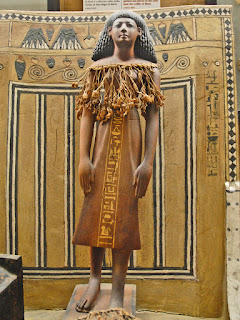''The lady of Brussels'
Inventory number: E.0752
The lady of Brussels', from the Hagemans collection, is one of the oldest known examples of large-scale statuary in stone. Its archaic style allows it to be dated to the beginning of the 3rd Dynasty. The standard conventions of Egyptian statuary are already clearly in use here. The symmetry of the face and the wig is perfect. The left arm is folded across the chest, the right arm is stretched out close to the body and the legs
...are close together. The 'lady' is dressed in a long robe which hugs her figure.
3RD DYNASTY
R. Tefnin, Sculptuur van het Oude Egypte - Statues et statuettes de l'Ancienne Égypte, Bruxelles 1988, 16-17
J.-Ch. Balty, e.a., Koninklijke Musea voor Kunst en Geschiedenis, Brussel, Oudheid - Musées Royaux d'Art et d'Histoire, Bruxelles, Antiquité - The Royal Museums of Art and History, Brussels, Antiquity, Bruxelles 1988, 14
Koninklijke Musea voor Kunst en Geschiedenis. Algemene gids met plan - Musées Royaux d'Art et d'Histoire. Guide général et plan, Bruxelles 1989, 8
F. Lefebvre et B. Van Rinsveld, L'Égypte. Des Pharaons aux Coptes, Bruxelles 1990, 34-35
Van Nijl tot Schelde - Du Nil à l'Escaut (Exposition), Bruxelles 1991, 53 n° 51
Th. De Putter et Chr. Karlshausen, Les pierres, Bruxelles 1992, 65
W. Seipel, Gott, Mensch, Pharao. Viertausend Jahre Menschenbild in der Skulptur des Alten Ägypten (Exposition), Vienne 1992, 84-85
M. Raven, The Lady of Leiden. A Monumental Bronze Figure and its Restoration, dans Aegyptus Museis Rediviva. Mélanges H. De Meulenaere, Bruxelles 1993, 129
Koninklijke Musea voor Kunst en Geschiedenis, Jubelparkmuseum - Musées royaux d'Art et d'Histoire, Musée du Cinquantenaire - Königlichen Museen für Kunst und Geschichte, Jubelparkmuseum - Royal Museums for Art and History, Cinquantenaire Museum, Bruxelles 1994, 12
Museumstukken als figuranten in een stripverhaal - ...Quand la BD s'inspire des objets du Musée (Exposition), Bruxelles 1996, 10
N. Cherpion, La statuaire privée d'Ancien Empire: indices de datation, in N. Grimal (Éd.), Les critères de datation stylistiques à l'Ancien Empire, Le Caire 1998, 119
H. Sourouzian, Concordances et écarts entre statuaire et représentations à deux dimensions dse particuliers de l'époque archaïque, in N. Grimal (Éd.), Les critères de datation stylistiques à l'Ancien Empire, Le Caire 1998, 340 fig.24
globalegyptianmuseum
KMKG - MRAH





















 aka Pahekamen (or Paheqamen)
aka Pahekamen (or Paheqamen) 






















